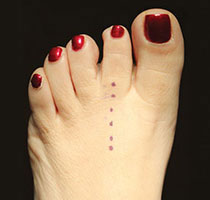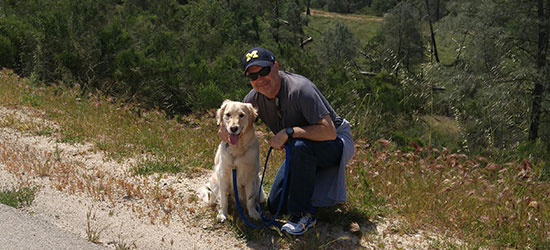- Home
- Foot & Ankle Conditions
- Plantar Plate Injuries
Plantar Plate Injury: causes, symptoms and treatments
- Published 10/8/2018
- Last Reviewed 12/27/2023
What's the plantar plate?
The plantar plate is a strong ligament on the bottom of the foot. It’s a fibrous structure that connects the base of your toe (proximal phalanx) to the forefoot bone (metatarsal head). The plantar plate runs through the joint capsule within the forefoot. Each of your toes, from the big toe to the pinky, has a plantar plate.
Plantar plates keep the toes in place and stop them from over-extending or drifting. As a stabilizer for the metatarsophalangeal joints, plantar plates act as an attachment site for the plantar fascia and your other ligaments and tendons.
A plantar plate tear or injury (sometimes called pre-dislocation syndrome) may be more common than you realize, and you may have even suffered one. Because a common symptom of a plantar plate injury is the second or third toe crossing over its neighbor, these injuries are also called “crossover toe deformities.”
- What causes plantar plate tears?
- What are the symptoms of a plantar plate injury?
- Diagnosing a plantar plate tear
- Conservative treatments for plantar plate injuries
- Plantar plate repair surgical intervention techniques
- Which is better, Arthrex CPR or the HAT-TRICK procedure?
- What is plantar plate surgery recovery time?
- How to prevent plantar plate tears
- UFAI has the most advanced procedures to treat your plantar plate injury
- Frequently Asked Questions about Plantar Plate Tears and Plantar Plate Surgery
- Can a plantar plate tear heal on its own?
- What is the success rate for Plantar Plate repair surgery?
- Can you recommend some good shoes for plantar plate injuries?
-
ABFAS® Board Certified in Foot Surgery and Reconstructive Rearfoot and Ankle Surgery. and Director of University Foot and Ankle Institute
Dr. Bob Baravarian DPM, FACFAS is a Board-Certified Podiatric Foot and Ankle Specialist. He is an assistant clinical professor at the UCLA School of Medicine and serves as Director of University Foot and Ankle Institute.
Dr. Baravarian has been involved in athletics his entire life and played competitive tennis in high school and college. He has an interest in sports medicine, arthritis therapy, and trauma/reconstructive surgery of the foot and ankle. He is also fluent in five languages (English, French, Spanish, Farsi, and Hebrew),
-
ABFAS® Board Certified in Foot Surgery and Reconstructive Rearfoot and Ankle Surgery. and Director of University Foot and Ankle Institute
Dr. Bob Baravarian DPM, FACFAS is a Board-Certified Podiatric Foot and Ankle Specialist. He is an assistant clinical professor at the UCLA School of Medicine and serves as Director of University Foot and Ankle Institute.
Dr. Baravarian has been involved in athletics his entire life and played competitive tennis in high school and college. He has an interest in sports medicine, arthritis therapy, and trauma/reconstructive surgery of the foot and ankle. He is also fluent in five languages (English, French, Spanish, Farsi, and Hebrew),
Learn More from our Plantar Plate Blog Articles
 I love this practice. My experience at UFAI Institute has always been good. I have been a patient for almost a decade and as a ...Daniel J.
I love this practice. My experience at UFAI Institute has always been good. I have been a patient for almost a decade and as a ...Daniel J. My experience was very good. Dr. Kelman was quick but thorough. He has a good sense of humor and is very pleasant.Isabel B.
My experience was very good. Dr. Kelman was quick but thorough. He has a good sense of humor and is very pleasant.Isabel B. You were recommended by a friend and I will surely pass that to my friends shouldmany be inPhilip M.
You were recommended by a friend and I will surely pass that to my friends shouldmany be inPhilip M. He is informed,smart and current in information. Helped me a lot. Recommended Medicine for my toe nails,he cultured first and m...Theresa M.
He is informed,smart and current in information. Helped me a lot. Recommended Medicine for my toe nails,he cultured first and m...Theresa M. Would rather deal directly with the local office.Andrea G.
Would rather deal directly with the local office.Andrea G. Dr. Johnson is terrific: competent, caring, and communicative. Also, he shows he is a real human, not just filling a role of do...Sharon S.
Dr. Johnson is terrific: competent, caring, and communicative. Also, he shows he is a real human, not just filling a role of do...Sharon S. Your staff are always caring and professional.
Your staff are always caring and professional.
I like Dr Bob and Dr Gina very much.Linda T. You guys are really good over there. Okay, I love my doctor jafari. He's very knowledgeable. Makes me feel comfortable and yeah...David J.
You guys are really good over there. Okay, I love my doctor jafari. He's very knowledgeable. Makes me feel comfortable and yeah...David J. Dr Baravarian was a referral from a friend who also had bunion surgery with him. He is knowledgeable, respectful and very profe...Sue B.
Dr Baravarian was a referral from a friend who also had bunion surgery with him. He is knowledgeable, respectful and very profe...Sue B. Dr Johnson was really lovely and took the time to make my young son comfortable and at ease. He was honest about not being spec...Conaill H.
Dr Johnson was really lovely and took the time to make my young son comfortable and at ease. He was honest about not being spec...Conaill H. Dr. Naei and her staff are pleasant and accommodating. Dr. Naei listens and does everything within her power to assist the pati...Carmen F.
Dr. Naei and her staff are pleasant and accommodating. Dr. Naei listens and does everything within her power to assist the pati...Carmen F. Professional like none other. I’m super picky with who I appoint as my PC or Specialist so I went through the rounds of intervi...Arthur A.
Professional like none other. I’m super picky with who I appoint as my PC or Specialist so I went through the rounds of intervi...Arthur A.




